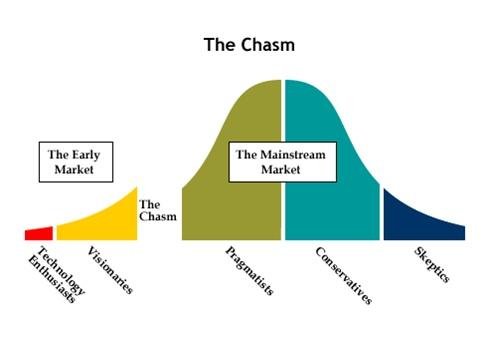Over the last few years there has been a barrage of SDN-related articles, reports, webinars and seminars. The extent of all of that discussion combined with the fact that there has been relatively limited deployment of SDN could cause network professionals to become cynical and wonder if SDN will ever become mainstream network architecture.
In his book "Crossing the Chasm: Marketing and Selling High-Tech Products to Mainstream Customers," Geoffrey Moore analyzes what it takes for a technology or architecture to go from being highly discussed to broadly deployed. Moore argues that there is a gap between the early adopters of a technology and the early majority, or pragmatists, and that these two groups approach the adoption of technology very differently.
For example, the early adopters of a technology are typically organizations that identify the primary use cases of a technology and that have both the capability and orientation to work through the issues that are associated with implementing early-stage technologies. In contrast, the early majority typically adopts a technology once the use cases have been identified and validated and once the solutions are stable.
Since Google and other companies have been implementing SDN for a couple of years, it's reasonable to ask, how much longer will it take before SDN crosses the chasm and is broadly deployed? Unfortunately, new technologies and architectural approaches take varying amounts of time and often take different paths to going mainstream. Some technologies, such as LAN switching, cross the chasm relatively quickly while others, such as voice over IP (VoIP), take a lot longer.
Some technologies, such as ATM in the LAN are broadly discussed but never make the leap into the mainstream while others such as ISDN do cross the chasm but still are not as successful in the market as was predicted. There are also instances in which a technological approach fails initially but then gets reincarnated in a somewhat different way and is widely deployed. An example of this would be acquiring applications from an Application Service Provider (ASP), which successfully shifted to Software-as-a-Service (SaaS).
So what will it take for SDN to cross the chasm? As mentioned, Moore argues that the early adopters identify the primary use cases and the early majority adopt a new technology or architecture once the use cases are identified and validated and once the solutions are stable. The good news is that unlike the situation just a year or two ago, we currently have a large number of SDN use cases that identify how you can use SDN. What we don’t have, however, is a lot of rock-solid business cases that demonstrate why you want to use SDN.
The lack of SDN-related business cases is in sharp contrast to what happened with VoIP. As VoIP was migrating from an early-adopter market to an early-majority market, vendors were falling over themselves to produce business cases that proved the economic value of implementing VoIP. That hasn’t happened yet with SDN and in order for SDN to become widely adopted, vendors need to step up and create those business cases.
I recently surveyed a couple of hundred IT professionals on a variety of topics relative to SDN; the results are in "The 2015 Guide to SDN and NFV."I provided survey participants with a list of impediments and asked them to indicate which would be the biggest inhibitors to their company adopting SDN in the next two years.
In addition to the lack of a compelling business case, two obstacles that bubbled to the top of the list were the immaturity of current SDN products and enabling technologies. This feedback illustrates Moore’s assertion that a technology or architecture won’t cross the chasm until the solutions are stable. Fortunately, as time passes SDN products and the technologies that enable them are becoming increasingly mature and stable.
However, another inhibitor that was just as important to survey respondents as the maturity of the enabling technologies was their concern about how they would integrate SDN into the rest of their infrastructure. As is the situation with SDN business cases, this is another place where vendors need to step up and create reference architectures and best practice documents that alleviate that concern.
So how will we know when SDN has hit the mainstream? I recently asked Neela Jacques, executive director of the OpenDaylight Project, this question. He replied that we will know SDN has crossed the chasm when there is a solution that is supported by a broad ecosystem so that whenever that solution is deployed, it tightly integrates with most, if not all, of the existing infrastructure and management tools. Jacques speculated that it would take three years for that to happen.









